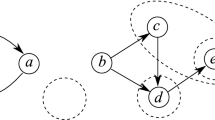On the set of all first-order theories T(σ) of similarity type σ, a binary operation {·} is defined by the rule T · S = Th({A × B | A |= T and B |= S}) for any theories T,S ∈ T(σ). The structure 〈T(σ); ⋅〉 forms a commutative semigroup, which is called a semigroup of theories. We prove that a semigroup of theories is an ideal extension of a semigroup \( {S}_T^{\ast } \) by a semigroup ST . The set of all idempotent elements of a semigroup of theories forms a complete lattice with respect to the partial order ≤ defined as T ≤ S iff T · S = S for all T,S ∈ T(σ). Also the set of all idempotent complete theories forms a complete lattice with respect to ≤, which is not necessarily a sublattice of the lattice of idempotent theories.
Similar content being viewed by others
References
J. Wierzejewski, “On stability and products,” Fund. Math., 93, 81-95 (1976).
W. Hodges, Model Theory, Enc. Math. Appl., 42, Cambridge Univ. Press, Cambridge (1993).
M. Machover, “A note on sentences preserved under direct products and powers,” Bull. Acad. Pol. Sci., Sér. Sci. Math. Astron. Phys., 8, 519-523 (1960).
Zh. A. Almagambetov, “On classes of axioms closed under given reduced products and powers,” Algebra i Logika, 4, No. 3, 71-77 (1965).
V. A. Gorbunov, Algebraic Theory of Quasivarieties, Sib. School Alg. Log. [in Russian], Nauch. Kniga, Novosibirsk (1999).
G. Birkhoff, Lattice Theory, Colloq. Publ., 25, 3rd ed., Am. Math. Soc., Providence, RI (1967).
S. Feferman and R. L. Vaught, “The first order properties of algebraic systems,” Fund. Math., 47, 57-103 (1959).
R. L. Vaught, “On sentences holding in direct products of relational system,” in Proc. Int. Congr. Math. (Amsterdam, 1954), Noordhoff, Groningen (1954), p. 409.
F. Galvin, “Horn sentences,” Ann. Math. Log., 1, 389-422 (1970).
J. M. Weinstein, “First order properties preserved by direct product,” PhD Thesis, Univ. Wisconsin, Madison (1965).
H. J. Keisler, “Ultraproducts and elementary classes,” Nederland Akad. Wet., Proc., Ser. A, 64, 477-495 (1961).
S. Shelah, “Every two elementarily equivalent models have isomorphic ultrapowers,” Israel J. Math., 10, 224-233 (1971).
D. Rees, “On semi-groups,” Proc. Camb. Philos. Soc., 36 (1940), 387-400.
Author information
Authors and Affiliations
Corresponding author
Additional information
M. I. Bekenov is supported by MES RK, project No. AP09259295.
Translated from Algebra i Logika, Vol. 60, No. 1, pp. 3-22, January-February, 2021. https://doi.org/10.33048/alglog.2021.60.101
Rights and permissions
About this article
Cite this article
Bekenov, M.I., Nurakunov, A.M. A Semigroup of Theories and Its Lattice of Idempotent Elements. Algebra Logic 60, 1–14 (2021). https://doi.org/10.1007/s10469-021-09623-1
Received:
Accepted:
Published:
Issue Date:
DOI: https://doi.org/10.1007/s10469-021-09623-1



